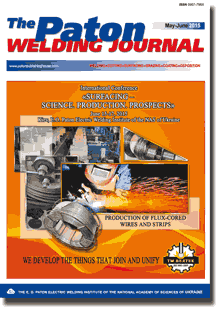| 2015 №06 (02) |
DOI of Article 10.15407/tpwj2015.06.03 |
2015 №06 (04) |

The Paton Welding Journal, 2015, #5-6, 14-21 pages
Energy approach in analysis of microplasma powder surfacing modes
A.V. Yarovitsyn
E.O. Paton Electric Welding Institute, NASU. 11 Bozhenko Str., 03680, Kiev, Ukraine. E-mail: office@paton.kiev.ua
Abstract
A new procedure for analysis of microplasma powder surfacing modes was proposed on the basis of evaluation of the value of definite integral of welding current magnitude during the time of arc running on the item. It is realized by digital processing of signals from current and voltage sensors with galvanic decoupling from the welding circuit, registered using the analog-digital converter. Its algorithm allows evaluation of the amount of heat applied to the anode for different models of specialized surfacing equipment under the conditions of variation of welding current and of a number of stationary technological parameters, and correlating this value with micro- or macrocracking susceptibility of items from high-temperature nickel alloys in fusion welding. It is established that at limited welding current overall heat input of micropalsma arc into the anode is proportional to weld pool volume and surfacing efficiency. In the case of multilayer surfacing of airfoil edge of GTE blade from JS32 and JS26 alloys it is shown that optimization of the total amount of heat energy allows prevention of microcracking in such a welded joint. 24 Ref., 8 Figures.
Keywords: data acquisition systems, microplasma powder surfacing, high-temperature nickel alloys, amount of heat applied to the anode, susceptibility to microcracking in fusion welding
Received: 15.04.15
Published: 28.07.15
References
1. (1988) Statistic assessment of metal transfer and stability of welding arcing: Procedural recommendations. Kiev: PWI.
2. Pokhodnya, I.K., Zaruba, I.I., Ponomaryov, V.E. et al. (1989) Criteria of evaluation of stability of DC arc welding process. Avtomatich. Svarka, 8, 1-4.
3. Pokhodnya, I.K., Zaruba, I.I., Ponomaryov, V.E. et al. (1990) Methods of comparative evaluation of technological properties of welding equipment and materials. Ibid., 5, 1-5.
4. Kirevsky, I.E., Amosov, A.P., Popov, V.V. (1997) Disturbance of stability of constricted arc running. Svarochn. Proizvodstvo, 4, 23-24.
5. Pirumov, A.E., Skachkov, I.O., Suprun, S.A. et al. (2007) Specialized complex for welding process monitoring. PiKAD, 4, 18-19.
6. Akinci, T.C. (2010) Time-frequency analysis of the current measurement by Hall effect sensors for electric arc welding machine. Mechanica, 85(5), 66-71.
7. Akinci, T.C., Nogay, H.S., Gokmen, G. (2011) Determination of optimum operation cases in electric arc welding machine using neural network. J. Mechanical Sci. and Technol., 25(4), 1003-1010. https://doi.org/10.1007/s12206-011-0202-9
8. Lebar, A., Selak, L., Vrabic, R. et al. (2012) Online monitoring, analysis and remote recording of welding parameters to welding diary. J. Mechanical Eng., 58(7/8), 444-452. https://doi.org/10.5545/sv-jme.2012.341
9. Paton, B.E., Korotynsky, A.E., Skopyuk, M.I. et al. (2002) System of in-process quality control of welding equipment during its manufacturing. The Paton Welding J., 5, 25-27.
10. Lankin, Yu.N., Ryabtsev, I.A., Soloviov, V.G. et al. (2014) Effect of electric parameters of arc surfacing using flux-cored wire on process stability and base metal penetration. Ibid., 9, 25-29. https://doi.org/10.15407/tpwj2014.09.03
11. Yarovitsyn, A.V., Yushchenko, K.A., Nakonechny, A.A. et al. (2009) Peculiarities of low-amperage argon-arc and microplasma powder cladding on narrow substrate. Ibid., 6, 31-35.
12. Yarovytsyn, O.V. (2009) Microplasma powder cladding of high-temperature nickel alloys with gВ-phase content of 45-65 %: Syn. of Thesis for Cand. of Techn. Sci. Degree. Kyiv: PWI.
13. (2010) Technological Seminar of Deloro Stellite in Saporozhie. The Paton Welding J., 1, 46-49.
14. Yushchenko, K.A., Savchenko, V.S., Yarovitsyn, A.V. (2010) Development of the technology for repair by microplasma powder cladding of flange platform faces of aircraft engine high-pressure turbine blades. Ibid., 8, 21-24.
15. Sorokin, L.I., Lukin, V.I., Bagdasarov, Yu.S. (1997) Weldability of cast high-temperature alloys of JS6 type. Svarochn. Proizvodstvo, 6, 12-17.
16. Sorokin, L.I. (1999) Stresses and cracks in welding and heat treatment of high-temperature nickel alloys. Ibid., 12, 11-17.
17. Yushchenko, K.A., Yarovitsyn, A.V. (2012) Improvement of technology for repair of upper flange platform face of aircraft gas-turbine engine blades. In: Transact. of NAS of Ukraine on Problems of resource and service safety of building and machine structures: Results of 2010-2012, 506-509. Kiev: PWI.
18. Gladky, P.V., Pereplyotchikov, E.F., Ryabtsev, I.A. (2007) Plasma surfacing. Kiev: Ekotekhnologiya.
19. Kester, W. (2010) Design of systems of digital and miscellaneous signal processing. Moscow: Tekhnosfera.
20. Izmajlov, D.Yu. (2009) PowerGraph: Handbook on signal processing functions, Pt2. PiKAD, 2, 26-28.
21. Petrov, G.L., Tumarev, A.S. (1967) Theory of welding processes (with fundamentals of physical chemistry). Moscow: Vysshaya Shkola.
22. Yarovitsyn, A.V., Novikov, S.V. (2009) Methodological support of immersion calorimetry of low-amperage arcs. In: Proc. of 5th All-Ukrain. Sci.-Techn. Conf. of Young Scientists and Specialists on Welding and Related Technologies (Kiev, Ukraine, 27-29 May, 2009). Kiev: PWI.
23. Zhiguo Gao, Ojo, O.A. (2012) Modeling analysis of hybrid laser-arc welding of single-crystal nickel-base superalloys. Acta Mater., 60, 3153-3167. https://doi.org/10.1016/j.actamat.2012.02.021
24. Frumin, I.I. (1961) Automatic electric arc surfacing. Kharkov: Metallurgizdat.
